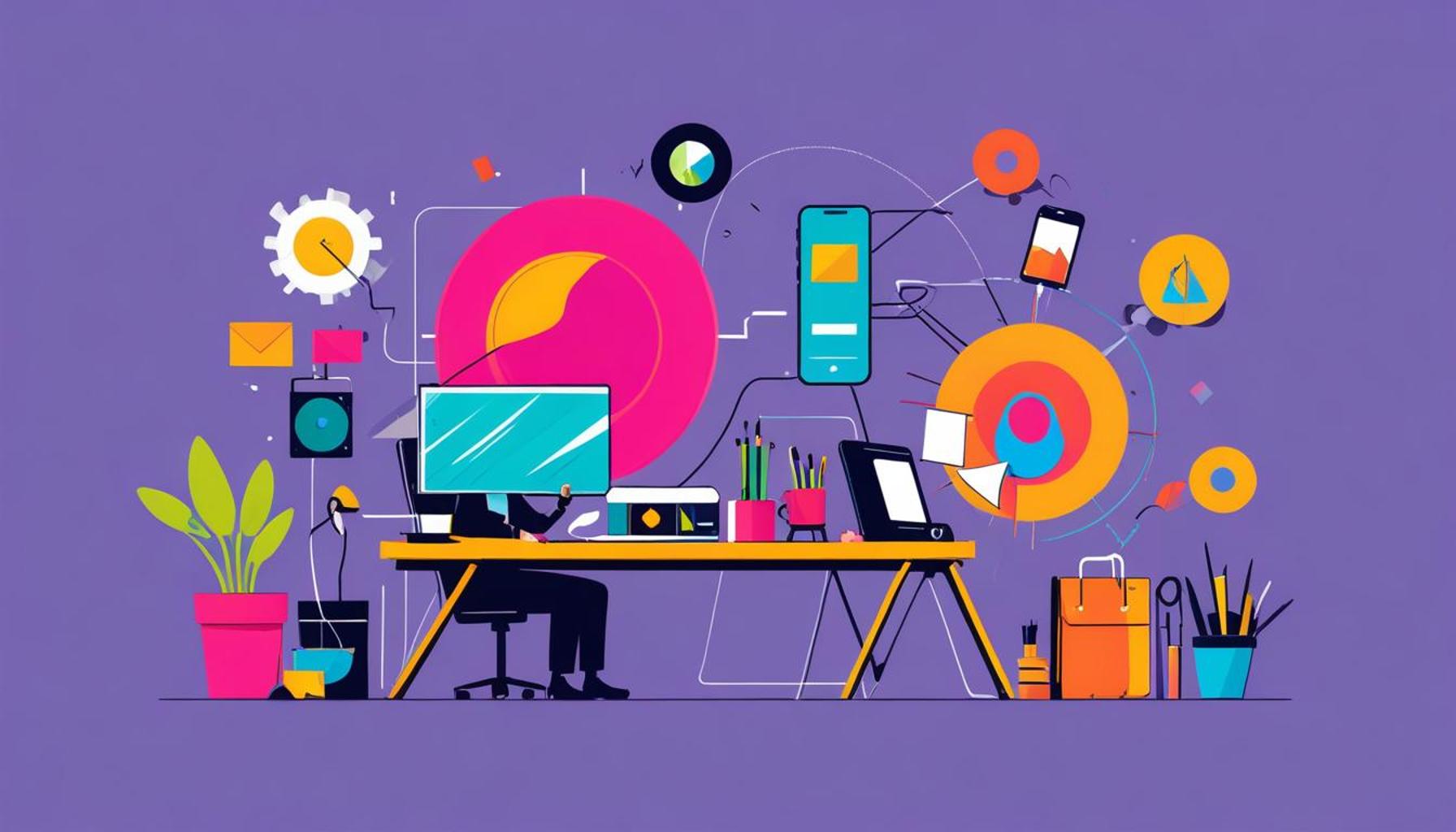Digital Minimalism: Creating Virtual Spaces Without Congestion

The Importance of Digital Minimalism
In our fast-paced digital era, the abundance of information can often feel overwhelming. With notifications constantly vying for our attention and an endless stream of content available at our fingertips, many individuals are discovering the need for a more structured approach to their virtual interactions. Embracing digital minimalism is more than just a trend; it is a proactive strategy for reclaiming control over our digital environments and making them work for us rather than against us.
Decluttering Your Digital Space
To begin your journey into digital minimalism, start by decluttering your digital life. This process involves taking a rigorous inventory of the applications, websites, and platforms that fill your screens. Ask yourself some critical questions: Are these tools essential for my daily tasks? Do they bring joy or merely add noise to my day? For instance, you might find that you have several social media apps that you barely use or that certain news outlets only serve to amplify stress. By removing the unnecessary elements, you create a more streamlined experience that enhances clarity.
Mindful Consumption
The next crucial aspect to consider is mindful consumption. In an age where algorithms shape what we see based on engagement rather than interest, it’s easy to fall into the trap of consuming content that does not enrich our lives. Instead, curate your feeds purposefully. Follow individuals and organizations that inspire you, educate you, or challenge your thinking positively. For example, subscribing to a digital magazine that focuses on topics you’re passionate about can help transform your brief scrolling sessions into times of learning and exploration.
Intentional Design
Moreover, intentional design in your digital space plays a crucial role in enhancing productivity. This involves not only tailoring your interface to suit your preferences but also organizing your files and apps in a way that aligns with your priorities. Simplified design can significantly reduce cognitive load, allowing you to focus on what truly matters. For instance, organizing your digital photographs into easily accessible folders by event or year can save time and decrease frustration when searching for specific images. Similarly, employing tools that block distracting websites during work hours can foster an environment conducive to concentration.

In light of research highlighting the stress associated with excessive screen time—including an increase in anxiety levels among heavy users—it is no surprise that so many are turning to digital minimalism as a solution. Studies from the American Psychological Association emphasize the mental health benefits that can be gained from reducing digital clutter and reigning in mindless consumption.
As we navigate through numerous strategies to implement digital minimalism, we find that the effort is well worth it. From curating your social media presence to clarifying your organizational system, each proactive step contributes to crafting a more peaceful digital existence. Join the growing movement toward intentional online living, and discover how a simplified digital landscape can lead to a more fulfilling life.
DIVE DEEPER: Click here to discover more about digital minimalism
Navigating the Digital Landscape with Purpose
As we delve deeper into the realm of digital minimalism, it’s essential to emphasize the importance of strategic navigation within our virtual landscapes. With the rise of countless productivity apps and digital platforms, the sheer volume of choices can lead to a sense of paralysis rather than empowerment. Thus, embracing a minimalist approach involves not just reducing clutter, but also enhancing the quality of our digital interactions.
Establishing Clear Boundaries
One of the foundational practices in achieving a minimalist digital life is establishing clear boundaries around your usage habits. This could mean setting specific times during the day when you check emails or social media, rather than allowing these activities to intrude on your focused work or personal time. The idea is to create structured routines that limit the urge to constantly be online. For example:
- Scheduled Breaks: Designate times throughout your day for digital check-ins, whether it’s a quick glance at your phone or a brief email review.
- Digital Detox Periods: Consider implementing tech-free evenings or weekends, when you can engage in offline activities or simply unwind.
- Limit Notifications: Adjust your notification settings to silence alerts from apps that are not vital, freeing you from the constant distractions that can derail your focus.
Implementing these boundaries not only aids in reducing screen time but also cultivates a mindful connection to technology. According to research from the Pew Research Center, participants who actively managed their technology use reported less stress and a general improvement in well-being. This suggests that personal breakthroughs in digital wellness are achievable through conscious choices.
Rethinking Communication Tools
In addition to boundary setting, reevaluating the communication tools you use can significantly impact your digital experience. Are you utilizing multiple messaging platforms for work and personal communication? Consolidating these methods can eliminate redundancy and simplify your interactions. For instance, consider using one application for work-related discussions and a different one for personal chats. This separation not only enhances organization but also helps maintain a focused mindset—a crucial aspect of digital minimalism.
With the increase of remote work and virtual collaboration, it’s easy to fall into the trap of perpetual connectivity. Embracing minimalism means resisting the pressure to always be available or to instantly respond. Instead, focus on meaningful exchanges that foster genuine relationships and collaboration, rather than ones that simply fill your screen with transient messages.
Ultimately, embarking on the journey of digital minimalism calls for a proactive shift in how we view technology. By thoughtfully selecting our digital tools and designing a balanced approach to usage, we can pave the way for a more intentional and fulfilling online existence. Each small change contributes to a larger transformation, enabling us to reclaim our time and attention from the grasp of digital overload.
| Advantage | Description |
|---|---|
| Enhanced Focus | Digital minimalism encourages a clutter-free digital environment, allowing users to concentrate on essential tasks without distractions. |
| Reduced Stress | By eliminating unnecessary notifications and apps, individuals experience less anxiety, promoting overall well-being while engaging with technology. |
| Streamlined Information Management | Adopting minimalism aids in organizing digital files and resources, ensuring that valuable information is easily accessible and used effectively. |
| Improved Productivity | A focused digital workspace results in higher productivity, as users spend less time sorting through irrelevant content. |
The tenets of digital minimalism challenge the norm of abundant digital distractions and advocate for meaningful engagement with technology. By embracing a philosophy that prioritizes simplicity, individuals can curate their virtual experiences, avoiding the pitfalls of endless scrolling and cognitive overload. This movement not only emphasizes the importance of intentionality in content consumption but also fosters an environment where creativity and clarity can thrive. The journey into minimalism inspires individuals to rethink their digital habits, ultimately leading to a more rewarding and fulfilling interaction with technology.
DISCOVER MORE: Click here to learn effective decluttering techniques
Curating Digital Content Wisely
In addition to setting boundaries and rethinking communication tools, another cornerstone of digital minimalism lies in curating the digital content we consume. The abundance of information available at our fingertips often transforms into an overwhelming torrent, leading us to feel lost amidst the chaos. To combat this, we must be intentional about the content we choose to engage with.
Quality over Quantity
One of the primary principles of digital minimalism is prioritizing quality over quantity. Instead of following numerous feeds, newsletters, or podcasts, take a step back to evaluate what truly adds value to your life. A study conducted by the American Psychological Association indicates that consuming high-quality content significantly enhances mental well-being compared to mindless scrolling through a barrage of updates.
To implement this approach:
- Unsubscribe from Uninspiring Sources: Regularly review your subscriptions and eliminate those that no longer resonate with your interests or goals. This serves to declutter your digital space and makes room for more meaningful content.
- Follow Purposeful Voices: Seek out creators, experts, and influencers who align with your values and aspirations. Aim for a curated selection that inspires learning, creativity, or personal growth.
- Utilize Content Aggregators: Consider using content aggregator platforms that compile articles and resources based on your interests, making it easier to find thought-provoking material without sifting through endless options.
Mindful Consumption Practices
Furthermore, implementing mindful consumption practices can significantly reduce digital congestion. When engaging with content, ask yourself whether it serves a specific purpose or simply fills time.
One practical strategy is to allocate specific time slots for consuming different types of media, such as articles, videos, or podcasts. Limiting this to a set period each day allows you to focus on enjoying the experience without getting lost in an endless cycle of content consumption.
Research from the Nielsen Company suggests that the average American adult spends over 11 hours per day engaged with media, a staggering amount that underscores the need for a more deliberate approach. By consciously selecting media experiences, we not only optimize our time but also reduce feelings of overwhelm associated with constant consumption.
Creating Virtual Spaces for Reflection
In the quest for digital minimalism, creating dedicated virtual spaces for reflection is equally essential. Consider designating certain platforms solely for inspiration or personal projects. For example, use tools like Pinterest solely for visual inspiration and separate digital spaces such as a blog or a note-taking app for personal journaling and reflection.
This way, you’ll cultivate a virtual environment conducive to creativity and relaxation rather than disarray and confusion. By zoning your digital experiences, you invite a sense of control and purpose into your online habits, further aiding in the quest for simplicity.
Overall, employing these strategies can significantly alleviate the burden of digital congestion. As we become more intentional with our digital interactions, we invite greater clarity and serenity into our lives. Embracing a minimalist approach allows us to forge a deeper connection with our online world, steering clear of distractions as we cultivate a purposeful digital existence.
DISCOVER MORE: Click here for sustainable organizing tips
Embracing a Clear Digital Landscape
In conclusion, the concept of digital minimalism serves as a beacon of hope in an increasingly chaotic online world. By focusing on intentionality, curating content that enriches our lives, and implementing strategies to zone our digital experiences, we can reclaim the clarity and peace we desire. As we navigate through the digital noise, it becomes apparent that simplification, rather than accumulation, is key. Research supports this, with studies revealing the mental health benefits of reduced media consumption and the profound difference that quality engagement makes in our lives.
By adopting the practices of purposeful content selection, mindful consumption, and creating dedicated virtual spaces for reflection, we empower ourselves to engage with technology in a way that enhances rather than hinders our daily existence. This mindful approach allows us to cultivate a more balanced relationship with our devices, steering clear of distractions while fostering creativity and growth.
The journey toward digital minimalism is not merely about limiting screen time; it is about redefining our entire digital experience. So, take a moment to evaluate your virtual habits. Are they bringing you joy, or are they adding to the congestion? The answers to these questions will guide you towards a more fulfilling digital life. As we continue to embrace these principles, we pave the way not just for a simplified online presence but for a richer, more meaningful connection with ourselves and the world around us.



